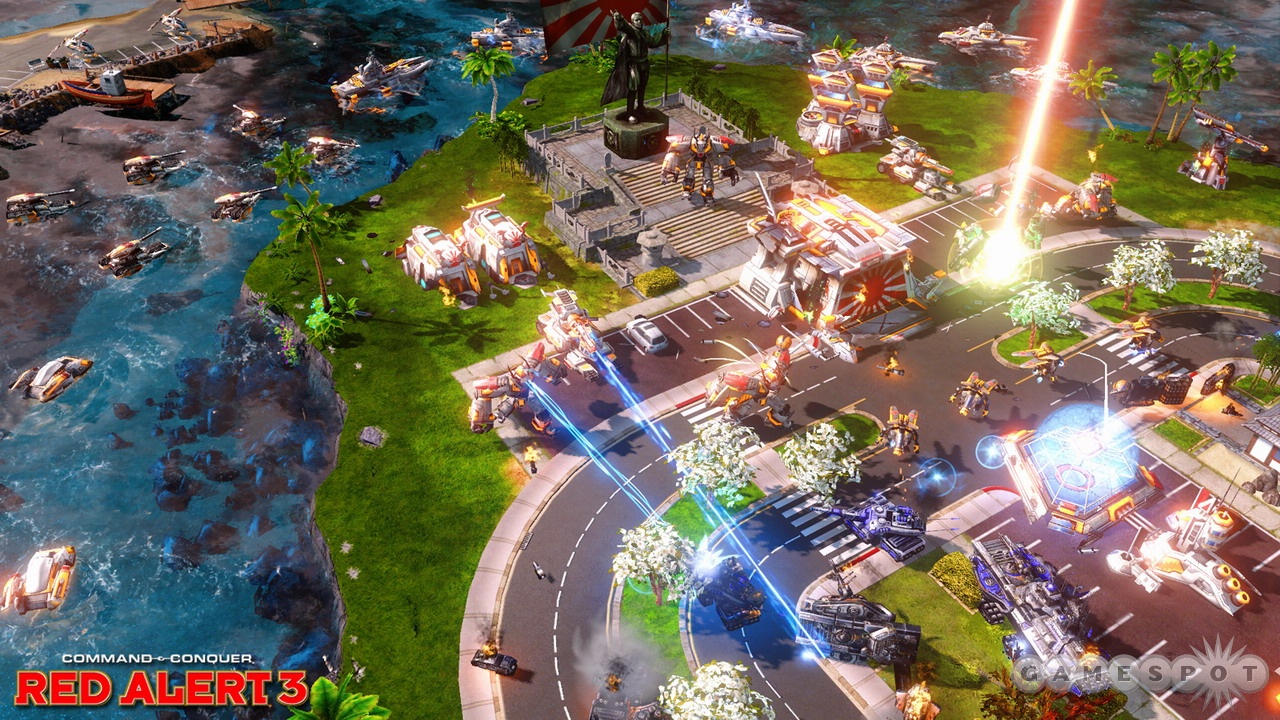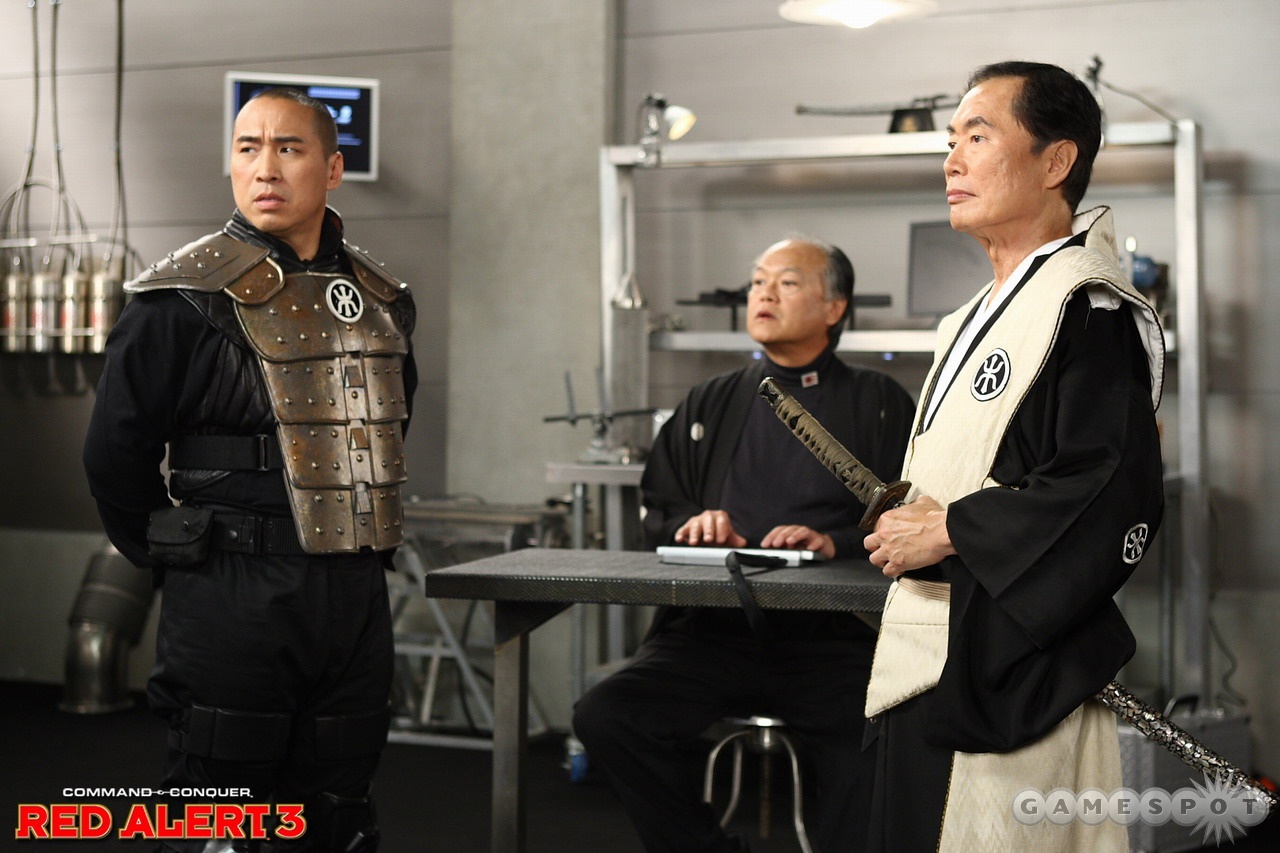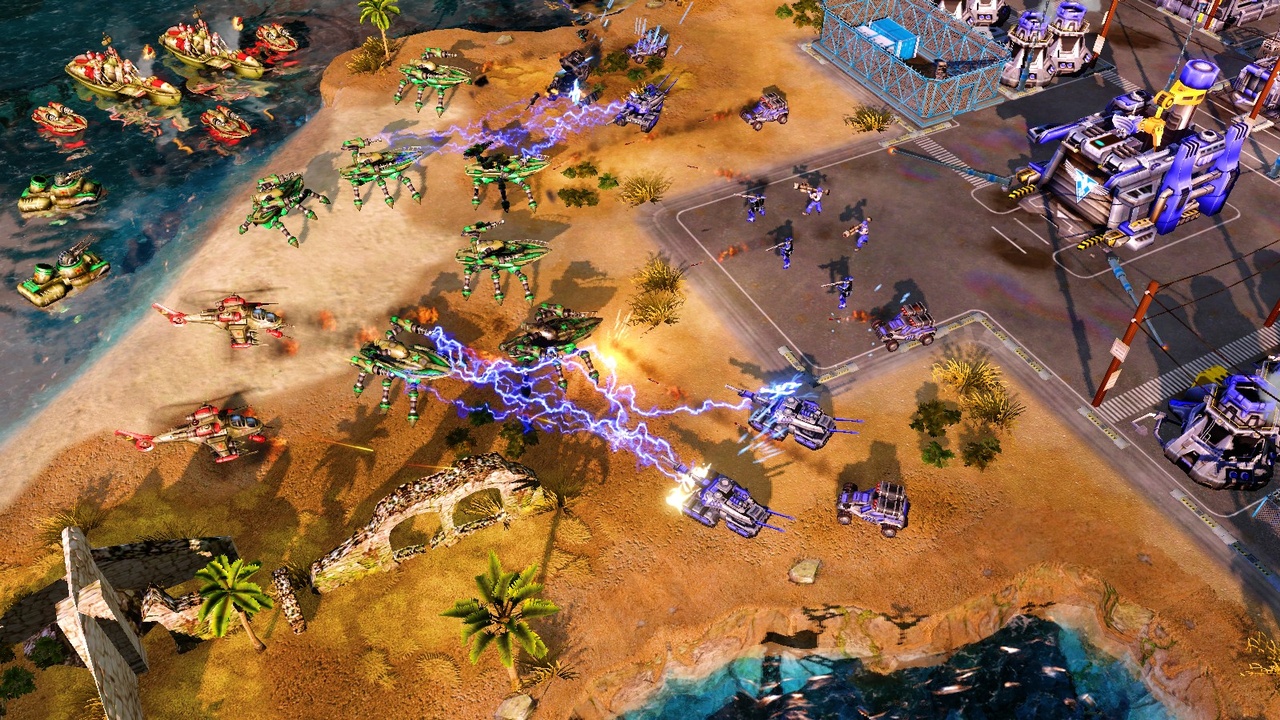Command & Conquer: Red Alert 3 Q&A: Empire of the Rising Sun
The Soviets and Allies have a new enemy, and his name is George Takei.
The Soviet war machine continues to grow. The Allies turn their attention to Moscow. Meanwhile, the Empire of the Rising Sun rises unimpeded in the alternate universe set forth in Command & Conquer: Red Alert 3. Without obstruction, the Empire is free to develop devastating technology straight from the pages of manga. Hybrid submarine planes, walking mechs, and Japanese schoolgirls fuel the Empire's war effort. We sat down with Red Alert 3 senior producer Amer Ajami for the latest details on the Empire of the Rising Sun. Here's what he had to say.
GameSpot: Red Alert 3 introduces a new faction, the Empire of the Rising Sun. What was your inspiration for the new faction? What sort of player will enjoy playing as the Empire most? And what is its motivation to destroy the Soviets and the Allies?
Amer Ajami: Look, I'm not going to lie to you. For the most part, we're all a bunch of nerds here at EALA. We read manga, we watch anime, and we play obscure Japanese games. In a sense, the Empire of the Rising Sun was our way of paying homage to the forms of Japanese pop culture that made a significant impact on our lives as we were growing up (you could also argue that some of us have yet to finish growing up). To that end, we drew influence from shows like Macross and Gundam when designing our Mecha Tengu and King Oni units, respectively. Movies like Akira and Kill Bill influenced the Empire's disturbed commando unit, Yuriko Omega. Even niche games like Ikaruga had a hand in the design of units like the Sea-Wing, which, like that game's namesake ship, flips horizontally between its white underside and black surface when switching between its primary and secondary modes.

We also needed an excuse, for the lack of a better word, to experiment with new gameplay that we hadn't seen a whole lot of in previous RTS games, but we were mindful of not changing the core mechanics of the Allies and Soviets. We figured fans of the Red Alert series had a certain expectation from those two factions, and that while we had some room to maneuver, we had to preserve their identity. In that regard, the Empire is the most unique faction in Red Alert 3--they have transforming units, they can build anywhere they want to, and they're generally extremely mobile. Because of this, they're a bit more nuanced than the Soviets or Allies and do take just a little bit of getting used to. Players who prefer to win battles by closely managing their forces rather than relying on overwhelming their opponents with sheer numbers will really enjoy the micromanagement-friendly nature of the Empire.
And as Red Alert concerns itself with time travel and alternate versions of post-World War II history, it felt natural to add a faction based on Japan, since that was the only major player from the war that wasn't involved in the first two games in the series.
GS: The Empire utilizes Mecha Tengu walkers and Sea-Wing submarine/jet hybrids. Tell us more about the unique units available to the Empire.
AA: Those are two of the faction's more memorable units, but really, the Empire is full of all kinds of interesting vehicles, infantry, ships, aircraft, and walkers that make use of futuristic weaponry and merciless tactics. The Mecha Tengu is probably my most favorite unit in the entire game, just because of how fun he is to fly around and transform depending on what kind of enemy forces I encounter. His voice responses and general characteristics were inspired by the punk bikers from Akira, and that adds another element of joy when using this unit. But there are plenty of other units in the Empire faction that are also noteworthy. The Shogun Battleship is a late-game bombardment naval vessel that draws some of its inspiration from Space Battleship Yamato. It's the most expensive unit available to the Empire, and for good reason, as its six guns can utterly annihilate enemy bases from a relatively far distance. It can also fatally ram nearby vessels if ever it needs to get out of a tight jam. Speaking of tight situations, the Shinobi is a superb anti-infantry soldier that can cut down enemies by the handful in close quarters using his katana, or by using his shurikens against targets that might be a bit farther away. The Empire of the Rising Sun has units that require precision, like the Rocket Angel and her ability to shut down any ground or naval unit, as well as units that fare better using brute force tactics, like the King Oni and his bull rush ability. Really, the entire faction is composed of a wide variety of highly unique and often dynamic units that can be used effectively in any situation.
GS: We know each unit in the game has a secondary ability. Given the secondary abilities of the Empire's units, which type of player do you think will enjoy playing with the Empire most? What are some examples of unique secondary abilities that really help define the faction?
AA: It's interesting that you mention the Mecha Tengu and the Sea-Wing because those are two of the faction's three transforming units--the third is the Striker-VX. As with every unit in Red Alert 3, those in the Empire have one primary ability and one secondary ability. In the case of these three transforming units, their secondary ability is to essentially switch roles altogether and become entirely new units. In its default state, the Mecha Tengu is a lightly armored ground vehicle that does a good job of harassing other early-game ground units like Soviet Bullfrogs or Allied infantry. In its secondary form, however, the Tengu transforms into a fast-attack jet that can only target (but is deadly against) air units. A smart player will use the Tengus in jet form to quickly get across the map and then transform them into their ground form to harass the enemy's starting forces. The VX is similar to the Tengu in that it can transform between ground and air states, though it can only target units that are on the opposite plane of the VX. That is, in its ground mode, the Strike-VX can only target air units, and in its air mode, the Chopper-VX can only target ground units. This ability is a lifesaver when a group of Chopper-VX units encounter some Soviets MiGs or Allied Apollos, as they can quickly transform into Striker-VX units and blow the jets they just ran into out of the sky.
In the hands of a skilled player, particularly one who can split his or her attention across the battlefield and anticipate the kinds of units and strategies that the enemy will be bringing to bear, the Empire of the Rising Sun can be incredibly effective (and lots of fun) to use.
GS: The Empire doesn't utilize a typical build structure, but instead utilizes buildings that can move almost anywhere on the map. What are the pros and cons of this mobile HQ strategy?
AA: That's right, the Empire's build mechanic differs greatly from that of either the Allies or the Soviets. While those two factions are restricted to building within a set distance from their construction yard, the Empire has no such limitation. Instead of building structures, the Empire trains compact mobile units called "cores" from their conyards. These cores can be trained up relatively quickly and are amphibious, so players can move them anywhere they want to on the map. Upon reaching their destination, they then unfurl into their respective structure.

Obviously, the advantage that this mechanic gives the Empire is that they can gain a strategic foothold on any given map quicker than the Allies or Soviets can, thus enabling them to make a play for tech structures and ore nodes before their opponents do. Resourceful players can also use this mechanic to employ unique strategies like parking a barracks outside of their enemy's base, or quickly set up an area to train and stage units away from their own base.
This mechanic does come with some pretty significant disadvantages, however. As an Imperial player, you're essentially paying for the cost of the entire structure up front when you train a core from your construction yard. What's more, the cores are a little slow and very lightly armored, which makes them extremely vulnerable to enemy fire, even from early-game scout units. Sending undefended cores to unfurl away from the safety of your base is a very risky proposition.
GS: We know that superweapons will slowly become available throughout the battle. What superweapons can the Empire employ to destroy its foes?
AA: Yeah, like the Allies and Soviets, the Empire of the Rising Sun has access to two superweapons late in their tech tree. Actually, to be a bit more specific, each of the game's three factions has one superweapon structure that can be used offensively or defensively, and one ultimate weapon structure that becomes available towards the end of any given battle--ultimate weapons can only be used offensively. In the case of the Empire, their superweapon is the nanoswarm, which casts an impregnable shield made up of billions of microscopic nannites that prevent anything within their range from moving into or out of that sphere. This weapon can be effectively used to protect your own units for a time, if you sense an impending attack on them. Conversely, it can be used against enemy units that may have caught you by surprise, holding them in stasis until you're able to call in your own forces.
The Empire's ultimate weapon is the psionic decimator, and it's a bit more straightforward to use. It's a structure that harvests the telekinetic energy of half a dozen psionic test subjects (many of whom bear a striking resemblance to the Empire's commando, Yuriko Omega) and unleashes all of that energy into a destructive and expanding ball of dark matter that essentially annihilates anything unfortunate enough to be within its range.
GS: Though the commando unit in previous games was a powerful anti-infantry and anti-structural unit, the Empire's Yuriko unit seems to be a totally different breed of commando. Tell us about this powerful unit and the best ways you've found to make use of her psychic powers.
AA: Yuriko actually isn't all that different from the Soviet's Natasha or the Allies' Tanya, at least on paper. She will wreak havoc on an opponent's base if she can manage to get close enough, and she can single-handedly dispose of almost every kind of vehicle or aircraft that's thrown at her, again much like her two counterparts in the other factions. In practice, however, she does have some distinctive features. First of all, she doesn't carry any weapons to speak of. Instead, she attacks structures and vehicles using nothing more than her mind. Buildings will take damage over a short time span, and she will lift vehicles, no matter how large, off the ground and crush them with a thought. She does the same thing to infantry, but because she can only target one soldier at a time (unlike Tanya, who can reacquire targets in a blink of an eye) and because she has to be fairly close to her target before attacking (unlike Natasha, who uses her sniper rifle to maintain a safe distance from her enemies), Yuriko is vulnerable to infantry, especially basic infantry like conscripts and peacekeepers. Of course, if she ever finds herself outnumbered by soldiers, she can use her psychokinetic burst secondary ability to send any nearby infantry hurtling towards their death.
GS: How do the top-level units of the Empire compare to those of the Soviets and Allies? How does the Empire benefit a bit more from scrambling up the tech tree, given that several of its midlevel units are very versatile and mobile and potentially outstanding early-game rushers?
AA: You're right that the Empire's early-game units excel at rushing and harassment, as I mentioned with the Mecha Tengu earlier. Their Burst Drone scout units and Tank Buster anti-vehicle infantry are also great at disrupting the enemy's activities early on in a match. As the Empire progresses up the tech tree, however, their nature changes somewhat from being a nimble and versatile harassment force to a decidedly more slow and plodding, though potentially devastating, army. This is nowhere more evident than the Shogun Battleship that I mentioned before, but also in units like the King Oni, a bruiser of a mech that is inspired by any number of anime like Gundam or Mazinger Z, or the Wave-Force Artillery, which is a long-range artillery unit that can unleash a massive beam weapon upon structures or slow-moving enemy vehicles. Granted, all three factions have their fair share of powerful late-game units, but the Empire's are the most pronounced, and potentially most deadly, especially when used smartly in conjunction with their more versatile early- to mid-game forces.

GS: Finally, is there anything else you'd like to add about the Empire faction?
AA: When we first started designing the Empire, we didn't know how it would be perceived by some of the more hardcore fans of the series. Certainly, it's a pretty big departure from what's been done in the first two Red Alert games, and they play completely differently from either the Soviets or the Allies. But that asymmetry between factions is something that was important to the design of Red Alert 3--we really wanted three distinct styles of play among the factions in order to add depth, cater to a wider audience of RTS gamers, and maintain the game's longevity. Judging from the reaction that the faction has received among the people who participated in the beta this summer, it's safe to say that the Empire has done just that.
Got a news tip or want to contact us directly? Email news@gamespot.com
Join the conversation